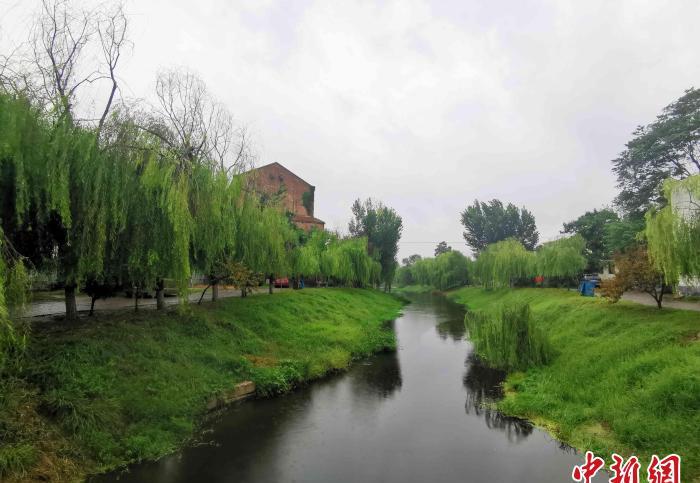
The Beijing-Hangzhou Grand Canal will pass through the Linqing section of the river. Photo by Zhao Xiao
Liaocheng, China News Network, September 1 (Zhao Xiao) The exquisite structure of AotouJi, the Guangyue Tower, which is deeply influenced by canal culture, the only remaining canal banknote in the country... The profound historical and cultural accumulation of the Beijing-Hangzhou Grand Canal has left many valuable cultural heritages to Liaocheng, Shandong, the "Jiangbei Water City". Among them, Linqing, located at the confluence of the Zhangwei River and the ancient canal, is born and prospered by the river, and at present, it adheres to the equal emphasis on protection and inheritance, and integrates the cultural heritage along the canal with resources, business forms, and cultural tourism, so that it can revitalize the vitality of the times.
Media reporters walked into the Linqing Canal to interview. Photo by Zhao Xiao
In 2014, China's Grand Canal World Cultural Heritage Application was successful, and the Linqing section of the Huitong River and the canal banknote customs became an important node. The reporter recently followed the Grand Canal National Cultural Park cultural and tourism integration and concentrated publicity media collection activities sponsored by the Department of Culture and Tourism of Shandong Province, and walked into Liaocheng Linqing, which is known as "prosperous and pressed two Beijings" and "rich Jiaqi County".
Media reporters visited the Linqing City Museum for an interview, and the picture shows the Linqing tribute bricks exhibited in the museum. Zhao Xiaozhao
The reporter saw at the canal banknote pass that there are still some well-preserved original banknote official residences here, and the buildings are mostly blue gray tile roofs. It is understood that the canal banknote pass is the only existing banknote pass site along the Grand Canal, which once ranked first among China's "eight major banknote passes". Zhu Feng, director of the Linqing Municipal Bureau of Culture and Tourism, said that the city plans to divide the banknote customs area into historical display areas, residential improvement areas, hotel folk life areas and other parts, through the creation, performance, interpretation and other methods, to achieve the purpose of the world cultural heritage to benefit the general public, and will use condensation of cultural traditions, highlighting regional characteristics, creating a spatial environment, implanting boutique formats and other ways to further explore the canal culture.
Zhao Qing'an, a municipal non-hereditary heir of Linqing gong brick firing technology, introduced the production process of tribute bricks to media reporters. Photo by Zhao Xiao
In order to make the canal culture and tourism better integrate and develop, Linqing City not only pays attention to the repair and protection of cultural relics and ancient buildings, but also strives to promote the rational use of cultural heritage. "We are promoting the exhibition and display of cultural heritage such as the Canal Banknote Pass, AotouJi, and the Stupa, and constantly improving the tourism function of cultural relics units through cultural exhibition display." Zhu Feng said that the city has also carried out environmental improvement of the canals in the Yuan and Ming dynasties, implemented projects such as greening on both sides of the river and repairing bridge gates, and initially built a canal heritage park integrating nature, history, and humanities.
Walking into the Linqing Weijiawan Tribute Brick Culture Dissemination and Display Base, Zhao Qingan, a municipal non-hereditary inheritor of linqing tribute brick firing technology, introduced more than 10 production processes of tribute bricks to reporters. During the Ming and Qing dynasties, tribute bricks arrived in The Beijing Division through water transport and were used to build royal buildings. Zhao Qing'an studied under his father, not only inheriting this skill, but also daring to innovate, combining the art of brick carving, so that Linqing tribute bricks can be integrated into modern life in a new form. "At present, Linqing Tribute Bricks not only renew their 'love affair' with the Forbidden City and become a unique item for the ancient construction and repair of the Forbidden City, but also use the forms of study tours and science popularization experiences to further expand their popularity and help more villagers to find employment and increase income."
Linqing Wanyuan, with canal culture as the connotation, carries out intangible cultural heritage activities. Zhao Xiaozhao
Linqing Wanyuan, which has canal culture as the connotation, excavates the cultural heritage of the ancient city of the canal by carrying out intangible cultural heritage activities. Liu Yating, director of the Linqing City Cultural Center, told reporters that local tourist attractions explore the path of integration with intangible cultural heritage, enriching and improving the cultural connotation and format of scenic spots. With the theme of display and experience of Linqing intangible cultural heritage, many intangible cultural heritage projects such as drums, dragon lanterns, face sculptures, guzheng, martial arts, and Peking opera are unveiled in scenic spots for tourists to visit, experience and purchase, enhance experiential and entertaining, and promote the integration of culture and tourism.
The heirs of the Jin's Guzheng perform in the Wanyuan Scenic Area. Photo by Zhao Xiao
Zhu Feng said that under the guidance of the cultural theme of the Grand Canal, Linqing City will fully integrate high-quality resources in the next step, so that it is suitable for integration, can be fully integrated, promote tourism with culture, promote culture with tourism, and promote the deep integration of culture and tourism. "Continue to increase the overall protection and inheritance of heritage along the canal, put the protection of heritage in the first place in the construction of the Grand Canal National Cultural Park, and systematically excavate the cultural value of the canal to create a grand canal cultural tourism brand." (End)
Source: China News Network